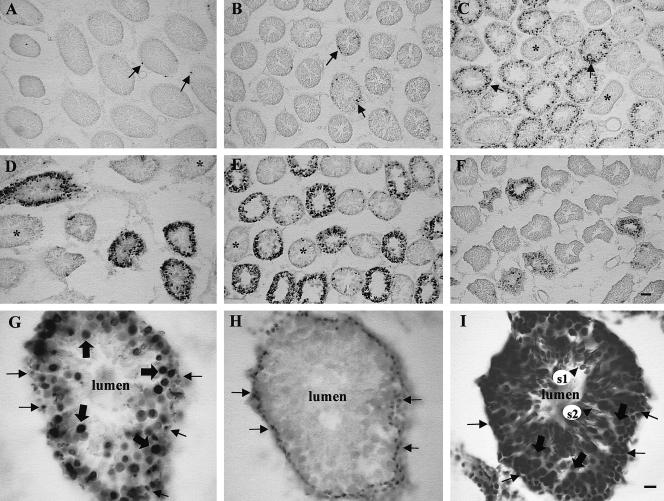Fig 3.
Hyperthermia induces cell death in the adult testis. Panels A–F: Time-course analysis of heat-induced cell death in cross-sections of adult rat seminiferous tubules. Terminal deoxynucleotidyl transferase–mediated deoxyuridine triphosphate nick-end labeling (TUNEL) staining was detected in a few peripheral cells of the seminiferous tubules in the unstressed control rat (panel A, arrows). The number of TUNEL-positive cells increased slightly at 2.5 hours (panel B, arrows), and a further increase, both in the number of tubules being affected and in the number of TUNEL-positive cells per tubule, was observed at 5 hours postheat (panel C). Asterisks (*) indicate tubules that did not appear to undergo heat-induced cell death. The number of TUNEL-positive cells continued to increase at 10 hours (panel D) and up to 15 hours after hyperthermia (panel E), which was the time point of maximal cell death, followed by a decline at 24 hours (panel F). Bar = 55 μm. Panels G–I: Adjacent sections of a 15-hour testis tubule at high magnification, processed with TUNEL (G), PCNA (proliferating cell nuclear antigen) immunocytochemistry (H), and cresyl violet stain (I), respectively. TUNEL labeling (G) shows that certain cell types were more sensitive to the heat than others. No cell death was observed in cells near the lumen. To aid in the identification of these cells, PCNA immunocytochemistry was performed (panel H), which selectively labels the mitotically active spermatogonia. Comparative analysis shows that type A spermatogonia (indicated by arrows) were susceptible to heat-induced cell death. The next layer of TUNEL-positive cells proceeding toward the lumen (large arrows) corresponded to primary spermatocytes, as was evident by cresyl violet staining (panel I). It was evident by the lack of TUNEL labeling in the lumen (panel G) that the round (s1) and elongating (s2) spermatids in panel I, located near the lumen, did not undergo cell death. Bar = 13.8 μm

